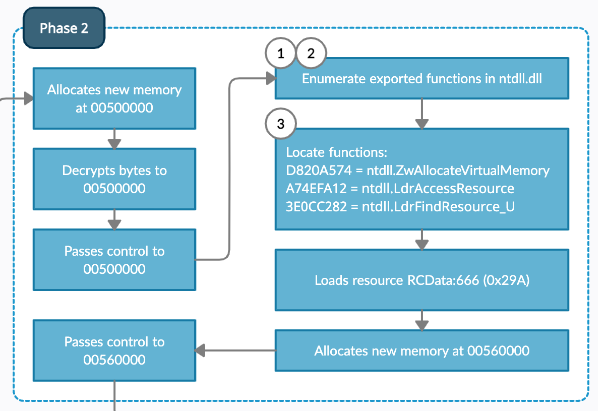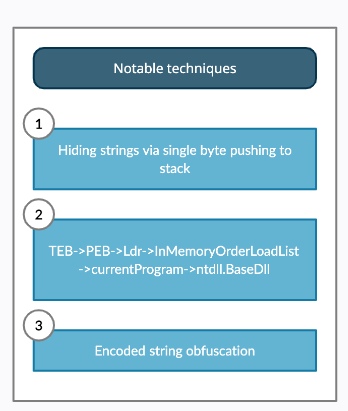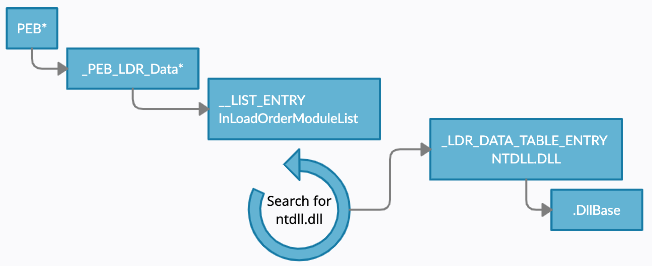Table of Contents
Intro
This is carrying on from the previous post on finding the start of the malicious user code in the MFC application. While continuing to step through there are several notable techniques that are worth mentioning as they are common for a lot of malware.
Due to the size of this sample I won’t be continuing to analyze every assembly instruction and will use a more dynamic approach to attempt to locate the key areas big actions take place like copying itself to a new location and deleting it’s original file as well as performing a series of posts to a large collection of C&C IPs.
This post will discuss three techniques seen early on:
- Hiding strings via single byte pushes to stack
- Getting DllBase and export table to crawl export functions of ntdll.dll and kernel32.dll
- Encoded string obfuscation
The malware sample used in this blog post
- MD5 hash:
a4513379dad5233afa402cc56a8b9222 - VirusTotal link to sample: https://www.virustotal.com/gui/file/ccd380ea868ffad4f960d7455fecf88c2ac3550001bbb6c21c31ae70b3bbf4f6/detection
Visual of observed flows
An overall digram of the beginning flow that contains the techniques to be discussed.

Numbers techniques are tied to in the diagram:

Notable Techniques
Hiding strings via single byte pushes to stack
Observe the following sequence of assembly. A repeating pattern of moving a single hex byte to EAX and pushing it to the stack is performed. NOTE: often it will be full DWORD’s that are pushed to put together a final string.
1
2
3
4
5
6
7
8
9
10
11
12
13
14
15
16
17
18
19
20
21
22
23
24
25
26
27
28
29
30
31
32
33
34
35
36
37
38
39
40
41
42
43
44
45
46
47
48
00500022 B8 6B000000 MOV EAX,6B
00500027 66:8945 98 MOV WORD PTR SS:[EBP-68],AX
0050002B B9 65000000 MOV ECX,65
00500030 66:894D 9A MOV WORD PTR SS:[EBP-66],CX
00500034 BA 72000000 MOV EDX,72
00500039 66:8955 9C MOV WORD PTR SS:[EBP-64],DX
0050003D B8 6E000000 MOV EAX,6E
00500042 66:8945 9E MOV WORD PTR SS:[EBP-62],AX
00500046 B9 65000000 MOV ECX,65
0050004B 66:894D A0 MOV WORD PTR SS:[EBP-60],CX
0050004F BA 6C000000 MOV EDX,6C
00500054 66:8955 A2 MOV WORD PTR SS:[EBP-5E],DX
00500058 B8 33000000 MOV EAX,33
0050005D 66:8945 A4 MOV WORD PTR SS:[EBP-5C],AX
00500061 B9 32000000 MOV ECX,32
00500066 66:894D A6 MOV WORD PTR SS:[EBP-5A],CX
0050006A BA 2E000000 MOV EDX,2E
0050006F 66:8955 A8 MOV WORD PTR SS:[EBP-58],DX
00500073 B8 64000000 MOV EAX,64
00500078 66:8945 AA MOV WORD PTR SS:[EBP-56],AX
0050007C B9 6C000000 MOV ECX,6C
00500081 66:894D AC MOV WORD PTR SS:[EBP-54],CX
00500085 BA 6C000000 MOV EDX,6C
0050008A 66:8955 AE MOV WORD PTR SS:[EBP-52],DX
0050008E 33C0 XOR EAX,EAX
00500090 66:8945 B0 MOV WORD PTR SS:[EBP-50],AX
00500094 B9 6E000000 MOV ECX,6E
00500099 66:894D B4 MOV WORD PTR SS:[EBP-4C],CX
0050009D BA 74000000 MOV EDX,74
005000A2 66:8955 B6 MOV WORD PTR SS:[EBP-4A],DX
005000A6 B8 64000000 MOV EAX,64
005000AB 66:8945 B8 MOV WORD PTR SS:[EBP-48],AX
005000AF B9 6C000000 MOV ECX,6C
005000B4 66:894D BA MOV WORD PTR SS:[EBP-46],CX
005000B8 BA 6C000000 MOV EDX,6C
005000BD 66:8955 BC MOV WORD PTR SS:[EBP-44],DX
005000C1 B8 2E000000 MOV EAX,2E
005000C6 66:8945 BE MOV WORD PTR SS:[EBP-42],AX
005000CA B9 64000000 MOV ECX,64
005000CF 66:894D C0 MOV WORD PTR SS:[EBP-40],CX
005000D3 BA 6C000000 MOV EDX,6C
005000D8 66:8955 C2 MOV WORD PTR SS:[EBP-3E],DX
005000DC B8 6C000000 MOV EAX,6C
005000E1 66:8945 C4 MOV WORD PTR SS:[EBP-3C],AX
005000E5 33C9 XOR ECX,ECX
005000E7 66:894D C6 MOV WORD PTR SS:[EBP-3A],CX
005000EB 8D55 B4 LEA EDX,DWORD PTR SS:[EBP-4C]
005000EE 52 PUSH EDX
All these bytes pushed to the stack result in the string seen below (also note, when pushing to the stack it is being done in reverse order). The malware could have just had the full string saved in the .data section and loaded it, however, it would then come up in static analysis when searching for strings.
Many variations of this technique are used to hide DLL names or names of exported functions it will later fetch via GetProcAddress so they don’t show up in the export table during static analysis.
1
2
3
4
0019F3EC 6B 00 65 00 72 00 6E 00 65 00 6C 00 k.e.r.n.e.l.
0019F3FC 33 00 32 00 2E 00 64 00 6C 00 6C 00 00 00 19 00 3.2...d.l.l....
0019F40C 6E 00 74 00 64 00 6C 00 6C 00 2E 00 64 00 6C 00 n.t.d.l.l...d.l.
0019F41C 6C 00 l.
Getting DllBase and export table
Another sequence of calls that must be known has to do with getting the Process Environment Block (PEB), the LoaderData, the ModuleList, and the export table. Let’s take a look at two important structures and their offsets.
The Thread Environment Block (TEB) can be accessed via calls that look like DWORD PTR FS:[30]. In fact his is the most common one as its gets a reference to the PEB structure which is where the rest of the crawling around the structures typically start from.
The following structures and offsets are referenced in the following examples.
Thread Environment Block (TEB)
1
2
3
4
5
6
7
8
struct TEB {
DWORD EnvironmentPointer; //+1C
DWORD ProcessId; //+20
DWORD threadId; //+24
DWORD ActiveRpcInfo; //+28
DWORD ThreadLocalStoragePointer; //+2C
PEB* Peb; //+30
...and more...
Process Environment Block (PEB)
1
2
3
4
5
6
7
8
9
struct PEB {
char InheritedAddressSpace; //+00
char ReadImageFileExecOptions; //+01
char BeingDebugged; //+02
char Spare; //+03
DWORD Mutant; //+04
DWORD ImageBaseAddress; //+08
_PEB_LDR_DATA* LoaderData; //+0C
...and more...
PEB Loader Data
1
2
3
4
5
6
7
8
9
10
11
struct _PEB_LDR_DATA {
DWORD Length_; //+00
DWORD Initialized; //+04
DWORD SsHandle; //+08
__LIST_ENTRY InLoadOrderModuleList; //+0C
__LIST_ENTRY InMemoryOrderModuleList; //+14
__LIST_ENTRY InInitializationOrderModuleList; //+1C
DWORD EntryInProgress; //+24
DWORD ShutdownInProgress; //+28
DWORD ShutdownThreadId; //+2C
};
PEB Loader Data Entry
1
2
3
4
5
6
7
8
9
10
11
12
13
14
15
16
struct _LDR_DATA_TABLE_ENTRY{
__LIST_ENTRY InLoadOrderLinks; //+00
__LIST_ENTRY InMemoryOrderLinks; //+08
__LIST_ENTRY InInitializationOrderLinks; //+10
DWORD DllBase; //+18
DWORD EntryPoint; //+1C
DWORD SizeOfImage; //+20
DWORD FullDllNameLength; //+24
char* FullDllName; // _UNICODE_STRING //+28
DWORD BaseDllNameLength; //+2C
char* BaseDllName; //_UNICODE_STRING //+30
DWORD Flags; //+34
short LoadCount; //+38
short TlsIndex; //+3C
...and more...
};
In our sample, we have the following function. It attempts to get the base address of ntdll.dll through the following sequence of structure crawling:

The below assembly can be summed up as “find ntdll.dll and return the base address of it”.
1
2
3
4
5
6
7
8
9
10
11
12
13
14
15
16
17
18
19
20
21
22
23
24
25
26
27
28
29
30
31
32
33
34
35
36
00500260 55 PUSH EBP
00500261 8BEC MOV EBP,ESP
00500263 83EC 10 SUB ESP,10
00500266 64:A1 30000000 MOV EAX,DWORD PTR FS:[30] ; PEB
0050026C 8945 F4 MOV DWORD PTR SS:[EBP-C],EAX
0050026F 8B4D F4 MOV ECX,DWORD PTR SS:[EBP-C]
00500272 8B51 0C MOV EDX,DWORD PTR DS:[ECX+C] ; _PEB_LDR_DATA* LoaderData
00500275 8955 F8 MOV DWORD PTR SS:[EBP-8],EDX
00500278 8B45 F8 MOV EAX,DWORD PTR SS:[EBP-8]
0050027B 8B48 0C MOV ECX,DWORD PTR DS:[EAX+C] ; __LIST_ENTRY InLoadOrderModuleList
0050027E 894D F0 MOV DWORD PTR SS:[EBP-10],ECX
00500281 8B55 F8 MOV EDX,DWORD PTR SS:[EBP-8]
00500284 8B42 0C MOV EAX,DWORD PTR DS:[EDX+C]
00500287 8945 FC MOV DWORD PTR SS:[EBP-4],EAX
0050028A 8B4D 08 MOV ECX,DWORD PTR SS:[EBP+8]
0050028D 51 PUSH ECX
0050028E 8B55 FC MOV EDX,DWORD PTR SS:[EBP-4]
00500291 8B42 30 MOV EAX,DWORD PTR DS:[EDX+30] ; name of running binary
00500294 50 PUSH EAX
00500295 E8 66000000 CALL 00500300 ; compare_strings
0050029A 83C4 08 ADD ESP,8
0050029D 85C0 TEST EAX,EAX
0050029F 75 08 JNZ SHORT 005002A9 ; do not match
005002A1 8B4D FC MOV ECX,DWORD PTR SS:[EBP-4] ; ECX = _LDR_DATA_TABLE_ENTRY
005002A4 8B41 18 MOV EAX,DWORD PTR DS:[ECX+18] ; EAX = DWORD DllBase
005002A7 EB 12 JMP SHORT 005002BB ; found match -> exit loop
005002A9 8B55 FC MOV EDX,DWORD PTR SS:[EBP-4]
005002AC 8B02 MOV EAX,DWORD PTR DS:[EDX]
005002AE 8945 FC MOV DWORD PTR SS:[EBP-4],EAX
005002B1 8B4D FC MOV ECX,DWORD PTR SS:[EBP-4]
005002B4 3B4D F0 CMP ECX,DWORD PTR SS:[EBP-10]
005002B7 ^ 75 D1 JNZ SHORT 0050028A
005002B9 33C0 XOR EAX,EAX
005002BB 8BE5 MOV ESP,EBP
005002BD 5D POP EBP
005002BE C3 RETN
Now that we have the DllBase of ntdll.dll we can go a step further and get to the EXPORT table to enumerate it’s exported functions (this same process can be done for any DLL, not just for ntdll.dll).
The following structure is the target of the next action this malware performs which is to get the exported names, addresses, and ordinals.
1
2
3
4
5
6
7
8
9
10
11
12
13
14
struct image_export_directory
{
unsigned long characteristics; //+00
unsigned long timestamp; //+04
unsigned short major_version; //+08
unsigned short minor_version; //+0A
unsigned long name; //+0C
unsigned long base; //+10
unsigned long number_of_functions; //+14
unsigned long number_of_names; //+18
unsigned long address_of_functions; //+1C // RVA from base of image
unsigned long address_of_names; //+20 // RVA from base of image
unsigned long address_of_name_ordinals; //+24 // RVA from base of image
};
The below function has access to the BaseDll address which is stored in EBP+8.
1
2
3
4
5
6
7
8
9
10
11
12
13
14
15
16
17
18
19
20
21
22
23
24
25
26
27
28
29
30
31
00500540 55 PUSH EBP
00500541 8BEC MOV EBP,ESP
00500543 83EC 20 SUB ESP,20
00500546 8B45 08 MOV EAX,DWORD PTR SS:[EBP+8] ; EAX = ntdll.dll->BaseDll
00500549 8945 F4 MOV DWORD PTR SS:[EBP-C],EAX
0050054C 8B4D F4 MOV ECX,DWORD PTR SS:[EBP-C]
0050054F 8B55 08 MOV EDX,DWORD PTR SS:[EBP+8]
00500552 0351 3C ADD EDX,DWORD PTR DS:[ECX+3C] ; PE offset (skip DOS header)
00500555 8955 F0 MOV DWORD PTR SS:[EBP-10],EDX
00500560 8B55 F0 MOV EDX,DWORD PTR SS:[EBP-10] ; PE offset
00500563 8B45 08 MOV EAX,DWORD PTR SS:[EBP+8] ; ntdll.dll->BaseDll
00500566 03440A 78 ADD EAX,DWORD PTR DS:[EDX+ECX+78] ; EXPORT table data entry
0050056A 8945 F8 MOV DWORD PTR SS:[EBP-8],EAX
0050056D 8B4D F8 MOV ECX,DWORD PTR SS:[EBP-8]
00500570 8B55 08 MOV EDX,DWORD PTR SS:[EBP+8]
; RVA of Name Pointer Table - addresses of exported function names
00500573 0351 20 ADD EDX,DWORD PTR DS:[ECX+20]
00500576 8955 EC MOV DWORD PTR SS:[EBP-14],EDX
00500579 8B45 F8 MOV EAX,DWORD PTR SS:[EBP-8]
0050057C 8B4D 08 MOV ECX,DWORD PTR SS:[EBP+8]
; RVA of Address Table - addresses of exported functions
0050057F 0348 1C ADD ECX,DWORD PTR DS:[EAX+1C]
00500582 894D E0 MOV DWORD PTR SS:[EBP-20],ECX
00500585 8B55 F8 MOV EDX,DWORD PTR SS:[EBP-8]
00500588 8B45 08 MOV EAX,DWORD PTR SS:[EBP+8]
; RVA of Ordinal Table - function order number as listed in the table
0050058B 0342 24 ADD EAX,DWORD PTR DS:[EDX+24]
When studying the PE-Format we can see that Win32 binaries have a DOS Stub that is placed at the front of the EXE image. The format states that:
“At location 0x3c, the stub has the file offset to the PE signature. This information enables Windows to properly execute the image file, even though it has an MS-DOS stub. This file offset is placed at location 0x3c during linking.”
With this known, we can view a table of offsets relative to DllBase+3C to make sense of which structures or addresses the malware is after in the above sample.
| Structure / Address | Offset |
|---|---|
| RVA of Export Table | 0x78 |
| address_of_functions | 0x78+0x1C |
| address_of_names | 0x78+0x20 |
| address_of_name_ordinals | 0x78+0x24 |
Now, with EBP-14 containing the addresses of exported function names we see it iterate over it via a counter in ECX and index to each subsequent item which are all 4 bytes long.
1
2
3
4
5
; ECX = counter
005005AE 8B4D FC MOV ECX,DWORD PTR SS:[EBP-4]
...
; index into next exported function name
005005B7 03048A ADD EAX,DWORD PTR DS:[EDX+ECX*4]
In this sample we are analyzing it is looping through searching for specific exported function names that are encoded in some way. As it will turn out, the method in which is encodes them doesn’t really matter but it does show another example of how the names would not turn up during the initial static analysis.
Encoded string obfuscation
This sample decrypted a resource file found as RCData = 666 (0x29A). You can see this if you view the original binary in Resource Hacker. It is mapped to 00560000 and called into via the following instruction:
1
00560024 E8 04000000 CALL 0056002D
In the following instructions we see a case where the name of the exported function was encoded in some way and stored. Upon looping through the exported function names via the previous technique it will use the same encoding function to generate a comparable string to perform a match on.
You can think of this similar to how passwords are hashed and the hash is stored. Upon typing a password in it re-hashes it in the same way and then compares them. This is essentially what we see here and the exact method of encoding becomes less important once it was understood exactly what the 00560467 function was doing.
1
2
3
4
5
6
7
8
9
10
11
12
13
14
15
16
17
18
19
20
21
22
23
24
25
26
27
28
29
30
0056002D 83EC 48 SUB ESP,48
00560030 836424 18 00 AND DWORD PTR SS:[ESP+18],0
00560035 B9 4C772607 MOV ECX,726774C
0056003A 53 PUSH EBX
0056003B 55 PUSH EBP
0056003C 56 PUSH ESI
0056003D 57 PUSH EDI
0056003E 33F6 XOR ESI,ESI
00560040 E8 22040000 CALL 00560467 ; 726774C = KERNEL32.LoadLibraryA
00560045 B9 49F70278 MOV ECX,7802F749
0056004A 894424 1C MOV DWORD PTR SS:[ESP+1C],EAX
0056004E E8 14040000 CALL 00560467 ; 7802F749 = KERNEL32.GetProcAddress
00560053 B9 58A453E5 MOV ECX,E553A458
00560058 894424 20 MOV DWORD PTR SS:[ESP+20],EAX
0056005C E8 06040000 CALL 00560467 ; E553A458 = KERNEL32.VirtualAlloc
00560061 B9 10E18AC3 MOV ECX,C38AE110
00560066 8BE8 MOV EBP,EAX
00560068 E8 FA030000 CALL 00560467 ; C38AE110 = KERNEL32.VirtualProtect
0056006D B9 AFB15C94 MOV ECX,945CB1AF
00560072 894424 2C MOV DWORD PTR SS:[ESP+2C],EAX
00560076 E8 EC030000 CALL 00560467 ; 945CB1AF = ntdll.ZwFlushInstructionCache
0056007B B9 33009E95 MOV ECX,959E0033
00560080 894424 30 MOV DWORD PTR SS:[ESP+30],EAX
00560084 E8 DE030000 CALL 00560467 ; 959E0033 = KERNELBA.GetNativeSystemInfo
00560089 8BD8 MOV EBX,EAX
0056008B 8B4424 5C MOV EAX,DWORD PTR SS:[ESP+5C]
0056008F 8B78 3C MOV EDI,DWORD PTR DS:[EAX+3C]
00560092 03F8 ADD EDI,EAX
00560094 897C24 10 MOV DWORD PTR SS:[ESP+10],EDI
00560098 813F 50450000 CMP DWORD PTR DS:[EDI],4550
In the above sample it has pre-encoded strings shown as 726774C, 7802F749, E553A458, C38AE110, 945CB1AF, and 959E0033. Once the matching function name (when encoded) matches this it will return the base address to it and store it in the stack for later use.
It utlimately resolves the following Win32 functions that it will use:
1
2
3
4
5
6
KERNEL32.LoadLibraryA
KERNEL32.GetProcAddress
KERNEL32.VirtualAlloc
KERNEL32.VirtualProtect
ntdll.ZwFlushInstructionCache
KERNELBA.GetNativeSystemInfo
These are important and very telling functions that you would want to break and understand what they are loading and or allocating. When you open CFF Explorer on the original file you will not see any of these listed in the Import Address Table (IAT).
